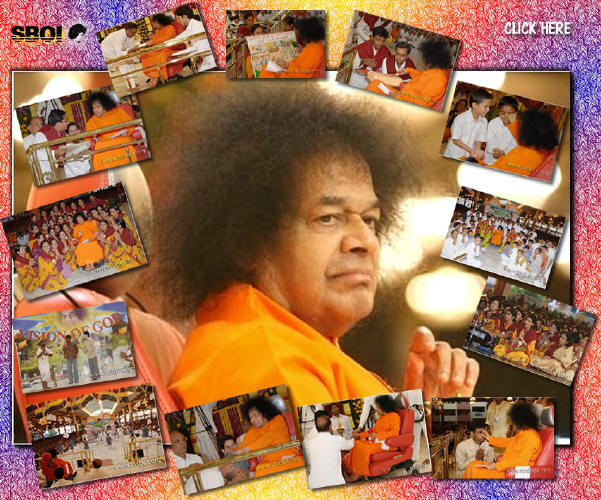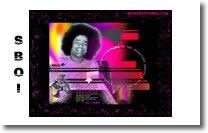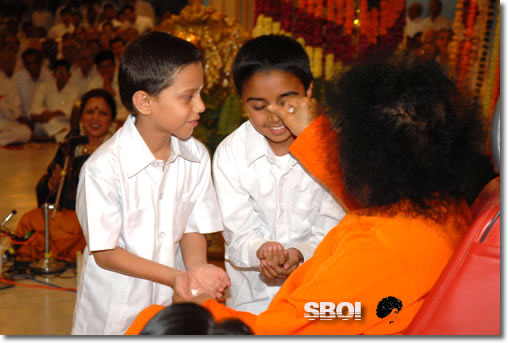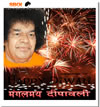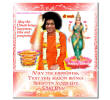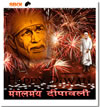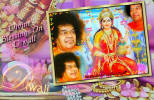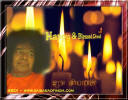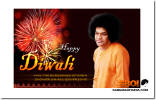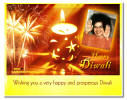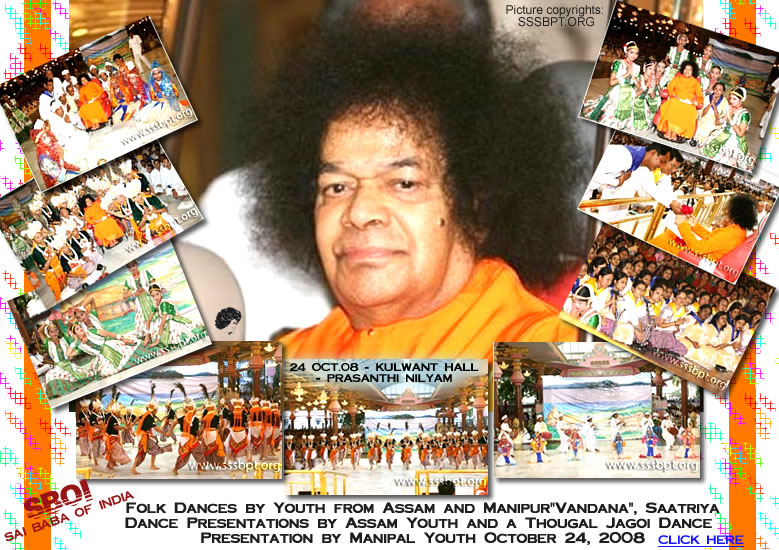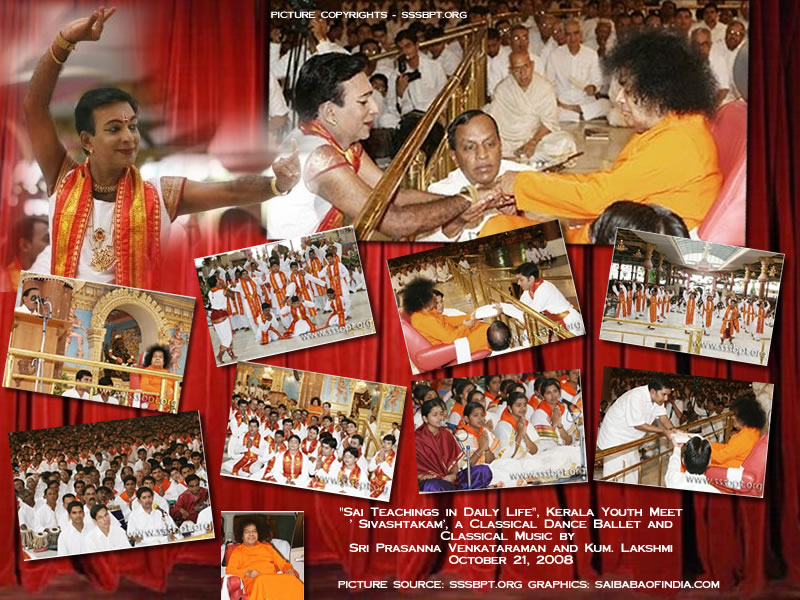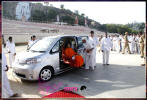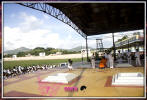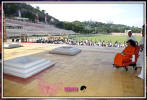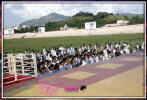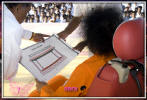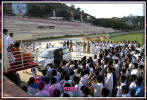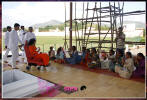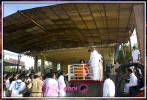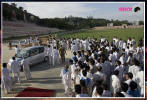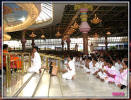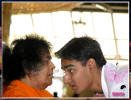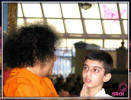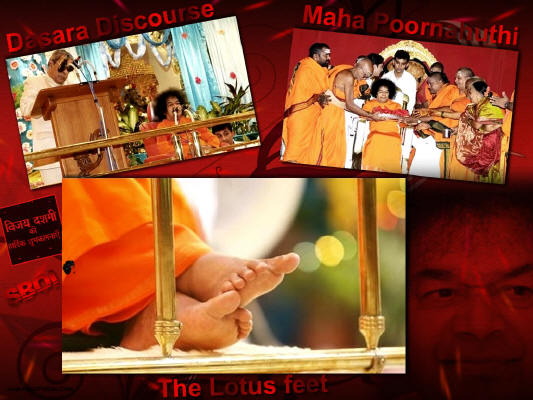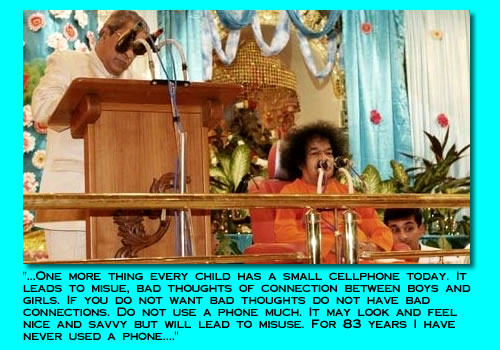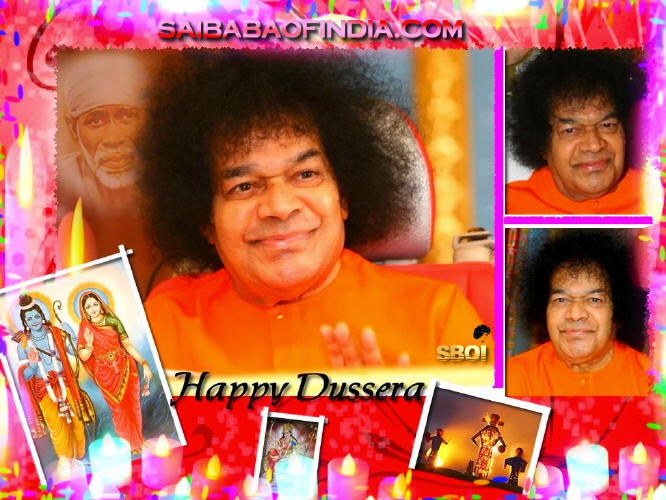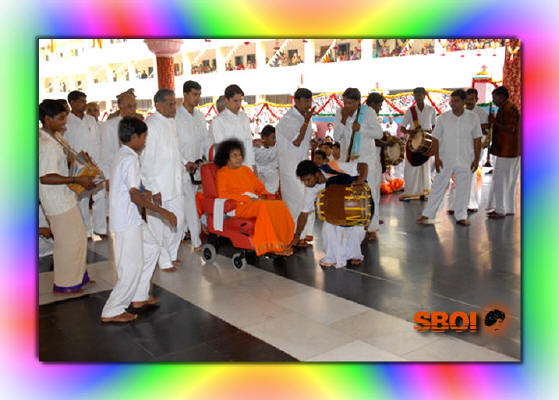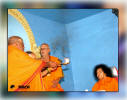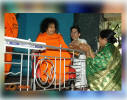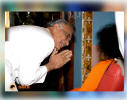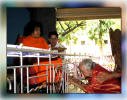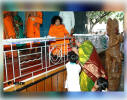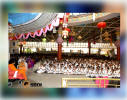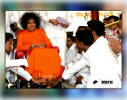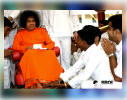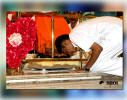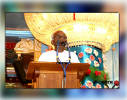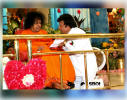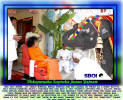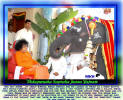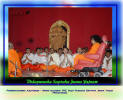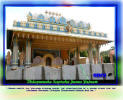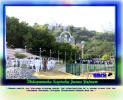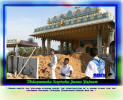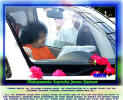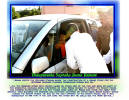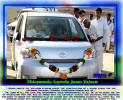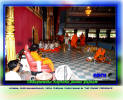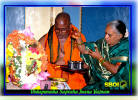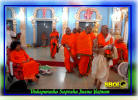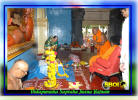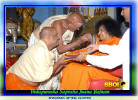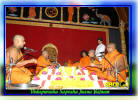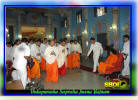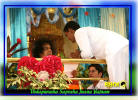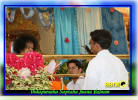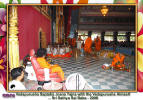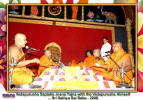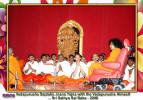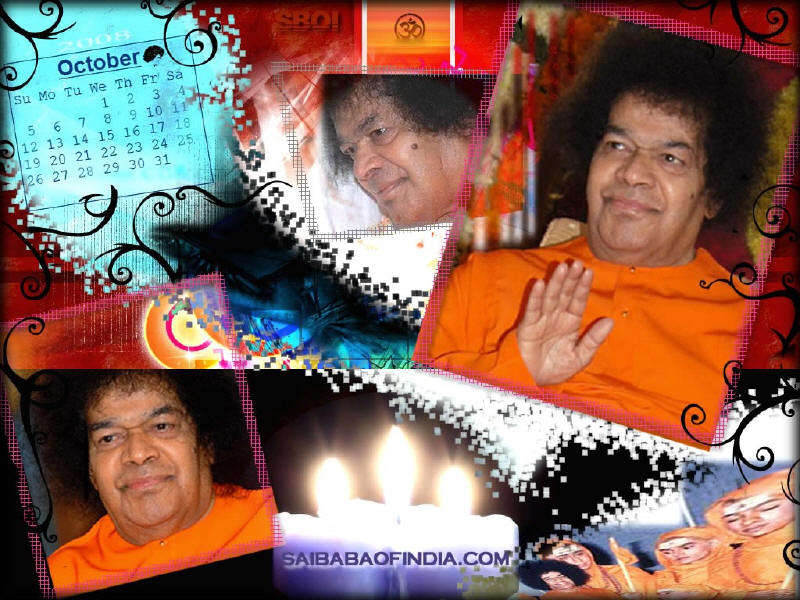| Acknowledgement -
Source: photos, text etc. Our humble
thanks to all Sai friends for Sai Baba photos & textual matter,
particularly to www. sssbpt.org - www. sairadio.org for darshans & photo
material and all the other official
& public domain sources - Also, Various Sai
Baba groups ,Forums & individuals etc. In addition, submitted articles,
Darshan account, photos & Sai news by respective Sai devotees from all
over the globe & SBOI group members to Group Saibabaofindia &
www.Saibabaofindia.com website. |
||||||||||||||||||||||||||||
|
|
||||||||||||||||||||||||||||
|
Thursday, October 30, 2008 The concluding programme of the devotees from Gujarat was based on real life experiences at Navsari in Gujarat in a drama entitled "Vision of the Divine". It was 5:10 pm when the programme began in the true sense as Swami came out to grant darshan! As always, the central area was kept empty and free and the backdrop stood majestic. Swami looked at it as He slowly passed by it and it was wonderful moment - Swami looking at a majestic backdrop that proclaimed, "Vision of the Divine". Completing the round, Swami moved to the stage. Once again, there was a parade of lucky souls who went up to Swami seeking blessings before the programme proper. It's a great opportunity and everyone utilizes it to the full. Swami blessed all the people who came up the stage and then the programme began.
|
||||||||||||||||||||||||||||
|
Wednesday, October 29, 2008 Today was the occasion of the Gujarati New year. The Gujarati New Year is synonymous with sud ekam of the Kartik month - the first day of the first month of Gujarati lunar calendar. Most other Hindus celebrate the New Year in early spring, but the Gujarati farming community celebrates the New Year after Diwali to mark the beginning of a new fiscal year. More than 2500 devotees had arrived specially for this occasion from Gujarat. It was at about 4:30 pm that Swami arrived to the chanting of the Vedas. The youth were seated in neat rows and were distinct by their deep brown scarves. Swami took a complete darshan round and then came on stage. He lit the lamp that had been decorated and placed for the occasion. It is interesting to note that the drama they were about to put up in a few minutes was called "Prema Jyoti" and here we had "Prema" lighting the "Jyoti"! Lighting the lamp, Swami went into the interview room for a short while. As soon as He came out on the stage again, He asked for the programme to begin. The opening was a parade of items for Swami to bless. Devotees from both the ladies and gents sections moved up the stage with cards, a lamp, brochures of the Grama Seva being done, fruit trays and even a cake. Swami slaked everyone's thirst for His proximity and blessed them too. Then the programme began. There was a 10 minute singing of welcome songs and Gujarati New Year songs. As that completed, the drama began. The drama portrayed the manner in which the Organization in Gujarat went about organizing the exhibition - Prema Jyoti. This exhibition had been inaugurated by Swami during the Guru Poornima of 2007 and by His will travelled the length and breadth of India conferring the joy of witnessing His Life and work to millions. Like any other noble endeavour, the organising of the exhibition too had its ups and downs but 'the Hand of God' was felt in every aspect of the work. Experiences based on the actual interaction of the volunteers on site with various people from the different walks of life were shown dramatically in the drama. Dance and music were embedded into the fabric of the plot. The conclusion was with a song and dance sequence and all the participants gathered in the centre and offered their prayers and Pranaams to Swami.
|
||||||||||||||||||||||||||||
|
Tuesday, October 28, 2008 Diwali, the festival of lights as it is often called arrives at a time in India when the chills of the winter are spreading their tentacles slowly over everything. It arrives as a warm thawing influence and along with the lights and sweets, warm feelings and loving thoughts are also distributed among all. Across many parts of India and Nepal, it is the homecoming of Lord Ram of Ayodhya, after a 14-year exile in the forest and his victory over the evil demon-king Ravan. In the legend, the people of Ayodhya (the capital of his kingdom) welcomed Ram by lighting rows (avali) of lamps (deepa), thus its name: Deepavali. Over time, this word transformed into Diwali in Hindi and Dipawali in Nepali, but still retained its original form in South and East Indian Languages. Celebrated as Narak Chaturdashi, one day before Diwali day, it commemorates the killing of Narakasura, an evil demon who created havoc, by Lord Krishna's wife Satyabhama. According to the Puranas, the goddess of Wealth, Prosperity and Luck Lakshmi was born from the churning of the Milk Ocean, along with other magical beings and objects on this day.
|
||||||||||||||||||||||||||||
|
Sunday, October 26, 2008 If yesterday it was the chance of the Iranian student to chant Vedam onstage, today it was the turn of the two American brothers, one in the school and one in the college. Bhagawan came onstage after His darshan round in the car at 4.30 pm, and asked Prof. Anil Kumar to announce that the Vedic hymns are not limited to any country or religion, and then called up the two American boys to chant onstage. After ten minutes of their chanting, Swami sat for a few more minutes while everyone chanted together, and then moved to the Bhajan Hall and then to the interview room. During the Bhajans which began at five o'clock in the Bhajan Hall, Swami asked for the two bhajans with Alap to be sung - 'Sri Raghavam' and 'Allah ho Akbar'. At 5.45, He accepted Arati and returned to His residence. |
||||||||||||||||||||||||||||
|
||||||||||||||||||||||||||||
|
Saturday, October 25, 2008 The evening darshan of 25th 'began' at about 5:10 pm as Swami came in the chair. By then, the bhajans had already begun and Swami slowly moved around the ladies and then the gents side. He passed through the students before coming to the stage. He came to the stage via the portico and moved through the teachers section collecting letters and speaking to many of them. Then smiling and granting an Abhayahastha, He came to the stage. As He sat tapping rhythmically to the bhajans, He called one of the members of the Vedam tutorial team and asked whether everyone had given up Vedam practice and chanting. With a surprised smile he replied to Swami that all were still learning and practising. Swami then began collecting letters from various students. He spoke to many of them too. As one student gave Him a letter, he prayed, "Swami let me keep you in my heart forever and pray to you." Swami said, "Keep me in your heart, that is enough." The student agreed, "As you say Swami." He then bent down to take paadanamaskar and unknown to him, Swami materialized a chain for him. Blissfully unaware, the boy was returning to his place when Swami called him and placed the chain lovingly around his neck. That being done, Swami seemed to move towards the bhajan hall after sitting for a while. But changing the route, He came out again and sat, this time far deep towards the gents side of the stage almost where the teachers are seated. He accepted another letter and asked a student as to where the "tall American boy" was? Apparently, that boy had gone to the hospital for some dental checkups. Swami then said that the bhajans going on be halted and the Veda chanting begin. He sent word for the Iranian Primary School student Sathya. He also called out one of the post graduate students and asked him to come over to the stage. The standing mikes were brought. Meanwhile Sathya arrived. The Rudram chanting that was on had reached the last anuvaka when Swami told all to cease chanting and the two boys, one standing talll, the other small; to begin chanting. They did so in tandem and wonderful synchronization. After that was complete, Swami asked them to restart the chanting and they both did that too confidently. Swami then called Prof. Anil Kumar and made him announce that Sathya was the first one from Iran to have so masterfully learnt the Vedas. There was a huge applause of celebration and congratulation. After that, the little boy asked Swami about something and also gave him a letter. Swami blessed him and then asked for Aarthi. The 26th also saw Swami in a highly "pro-Veda" mood if we are permitted to express it that way. Swami completed His darshan rounds in the car and came onstage at 4.30 pm. The students from the music college had some programme which they wanted to present before Swami. Swami seemed to be in a hurry and all watching knew for sure that He had something planned in mind. He blessed the card which had the details of the music programme and also the students carrying it. But then, if yesterday it was the chance of the Iranian student to chant Vedam onstage, today it was the turn of the two American brothers, one in the school and one in the college. He asked Prof. Anil Kumar to announce that the Vedic hymns are not limited to any country or religion, and then called up the two American boys to chant onstage. They chanted the first two anuvakas as an amazed crowd watched on at the ease and perfection which they delivered in a tongue that was figuratively, "Greek and Latin" for them! After their chanting, Swami sat for a few more minutes while everyone chanted together, and then moved to the Bhajan Hall and then to the interview room. During the Bhajans which began at five o'clock in the Bhajan Hall, Swami asked for the two bhajans with Alap to be sung - 'Sri Raghavam' and 'Allah ho Akbar'. At 5.45, He accepted Arati and returned to His residence. |
||||||||||||||||||||||||||||
|
Friday, October
24, 2008 The north eastern states of
Assam and Manipur had been blessed today to put up a programme in Swami's presence. A backdrop
had arisen as always when programmes are scheduled and boys and girls in costumes sat waiting
for the Lord. At about 4:00 pm, Swami came out in the car! Turning to His right immediately
after the Yajur mandir, Swami moved towards the Vidyagiri stadium where the construction of a
massive stage for the Yajna coming up is on. Quite a lot of progress seems to be happening
there. The whole stage was filled with a scaffolding and the sides had been completed. The
initial coats of painting too had been applied to the front face. A constant challenge is on
for the workers and engineers - if they want Swami to visit the site they must present
something new for Him to see! That in itself gifts enthusiasm and energy surges to toil hard.
Swami also had a look at the dining complex and the bathroom complexes being built specially
for the priests arriving for the Yajna. Then Swami returned to the Yajur Mandir. A short time later, Swami came for the darshan round in the chair this time. He looked at the painted backdrop as He neared the centre. Moving to the gents side, He completed the full round. He came on stage and for a while sat listening to the Veda chanting going on. Then asking for it to stop, Swami asked for the programme to begin. The respective State presidents offered roses to Swami and representatives of the participants also came to Swami with roses. The first presentation was from Assam - the Sattriya dance. Sattriya, or Sattriya Nritya, is one among eight principal classical Indian dance traditions. Whereas some of the other traditions have been revived in the recent past, Sattriya has remained a living tradition since its creation by the Assamese Vaishnav saint Srimanta Sankardeva, in 15th century Assam. Sankardeva created Sattriya Nritya as an accompaniment to the Ankiya Naat (a form of Assamese one-act plays devised by him), which were usually performed in the sattras, as Assam's monasteries are called. As the tradition developed and grew within the sattras, the dance form came to be called Sattriya Nritya. Today, although Sattriya Nritya has emerged from within the confines of the sattras to a much wider recognition, the sattras continue to use the dance form for ritualistic and other purposes for which it was originally created circa 500 years ago. There was the Guru Vandana and Krishna Vandana. The dance was performed by gracefully moving girls and it was a flowing slow dance. The next dance was presented by the youth of the Dakhinpat Satra in Majuli. It is interesting indeed to note that Majuli is the largest fresh water mid-river deltaic island in the world. It is situated in the upper reaches of the river Brahmaputra in Assam. This landmass, with a population of 1.6 Lakhs, majority being tribal, has a very rich heritage and has been the abode of Assamese Vashnavite culture with tremendous potential for spiritual and Eco-tourism. The island is a bio-diversity hotspot and has rich ecology with rare breeds of flora and fauna. Majuli has been the cultural capital and the cradle of Assamese civilization for the past five hundred years. The satras set up preserve antiques like weapons, utensils, Jewellery and other items of cultural significance. Such a diversity exists in India and in the world. And every people from every race and place rush to the abode of highest peace in Love for God! The youth performed the famous Govardhana lifting episode from Lord Krishna's life. Beating drums and dancing vigorously, they seemed to transport the onlookers to their native Assam and it felt so lively. This dance was performed by boys and had two tiers of dancers - those wielding the drums and those dressed in multicolours dancing in the front. Swami seemed so happy with the performance that as soon as it was completed, He clapped continuously for 10-12 seconds! The final presentation was by the youth from Manipur. They were to perform the "Thougal Jagoi" which means the dance to please the Gods and Goddesses. It is a composite dance form performed at the Lai Haraouba festival at Manipur. There is a great tradition behind this. Lai Haraoba is the festival of the recollection of the creation stories played by all these deities with the first origin of this universe and evolution of the plants and animals through the will of Atiya Shidaba. The origin of the festival is that the gods held the first Lai Haraoba on the Koubru hill, so that their descendants should imitate them and perform the same as it had been done by the deities so that they will never forget the secret and sacred story of the creation of this universe and the birth of the different lives on this earth. Youth clad in colourful clothes with peacock feathers adorning their heads performed on stage. With more than 30 youth, the stage was filled and the dance brought so much of movement and fullness to the stage. The postures and poses were so delicate that they seemed to melt into the other in rhythm and grace. Once their programme of about 15 minutes concluded, Swami asked for safari cloth pieces to be brought and distributed to all the performers. He got sarees for the girls. Meanwhile, the youth began bhajans and all the participants sat face to face with the Lord singing their hearts out. As an act of special Grace, He told the lady who was distributing the sarees to the girls also to keep one for herself. The lady broke down in tears of joy and seeing it, the meaning of "No reason for Love, no season for Love" got ingrained into greater understanding. Having done all that, Swami asked for the participants to sit in three neat groups and then gifted them with the ultimate blessing - a group photograph to carry home the wonderful memories and cherish them for a lifetime! Swami moved down and after the pictures were taken, everyone lucky enough to be near Him took the opportunity to touch His feet. Blessing them thus, Swami received Aarthi and then blessed prasadam to be distributed to all. |
||||||||||||||||||||||||||||
|
Tuesday, October 21, 2008 Today Swami had permitted the youth from Kerala to put up a programme they had come ready with as part of their Parthi pilgrimage. There was to be dance and music programmes and everyone sat in readiness. Swami came onstage after His darshan round by 4.30 pm, and in ten minutes, asked the Kerala State President Prof. Mukundan to introduce the programme. He offered the programme with Love and gratitude at Swami's Lotus Feet. The first programme was a dance performance and it began with the lead dancer offering a rose to Swami. The performance was by boys and men clad in white kurta pyjamas decked with a saffron sash around the waist and on their shoulders too. It was a semi-classical type of dance and all the participants seemed to form a moving human backdrop for the lead dancer. The lead dancer was agile and swift in his movements and was the highlight of the twenty minute long dance.
|
||||||||||||||||||||||||||||
|
"Sai Teachings in Daily Life", Kerala Youth Meet
|
||||||||||||||||||||||||||||
|
Monday, October,20,2008 Avatar Declaration
Day: It was 68 years ago on this day that the loving Lord decided to announce to all
mankind that He had indeed come to redeem and uplift them. It was the first time that He sang
out, "Manasa Bhajore Guru Charanam" and the world found in it an easy path to redemption and
liberation. For the devotees of Sri Sathya Sai Baba, the 20th of October is a day of special
significance. The Kulwant hall filled up in the morning and the students were conspicuous by their absence as they all had exams. Swami arrived for the morning darshan and took a complete round through the ladies and gents side. And that made the day truly special! We ultimately realize that more than the day making Swami special, it is Swami who makes the day special. When He moves around and decides to shower His grace in a manner that the physical eye can see, what day will not be deemed special? The bhajans began at 9:00am as usual and as expected, the bhajan "Manasa Bhajore" was sung. In the evening at about 4:00pm, Swami headed towards the Vidyagiri stadium. The stage being built for the Sahasra Chandra Darshanam Yajnam (SCDY)had been tiled and the Homakundas or the holy pits which will hold the sacred fire had also been completed. There were 12 homakundas in all. What is the SCDY actually? As explained traditionally, it is the celebration of the completion of 1000 full moon days of the divine incarnation. (Considering that there is a full mooon every 28 days.) But with Swami, it is more like the moon and all the other heavenly bodies celebrating the fact that they have witnessed the living avatar for a thousand times! This sacred programme which is being conducted for the well being of Mankind and for world peace, commences on the morning of Saturday, 15th November 2008 and culminates in Poornahuti on 17th November 2008. The programme will be conducted by hundreds of Vedic scholars arriving from various parts of India. Swami arrived at the Shanti Vedika and via a specially designed lift, ascended the stage. The main workers were seated on the corners of the stage and Swami smilingly blessed all of them. Like the morning, the mandir had missing students and that cannot be blamed on exams. The students, about two hundred of them, gathered around the stage to watch their beloved Swami supervising the constructions and arrangements! Some devotees who managed to sneak in through the gates along with Swami also stood beholding the beautiful sight. Swami went around the homakundas. He glanced at the roofing and asked whether it would be completely waterproof. He did not want any leakage. He was assured that layers of materials were being added and that the roof would be completely waterproof. Swami also enquired into the seating for the devotees. "They must be comfortable and must be able to see everything clearly", was the instruction. The engineer brought the plans and Swami had a thorough look at them. As He conducted the checks, He was also involved in another 'survey'! Every now and then, He would look at the hundreds who had gathered and His eyes would conduct a quick sweep. Like the rotating and revolving fan that brings relief and joy wherever it faces on a hot summer day, Swami's look brought the same if not greater joy and bliss even on this cool winter evening! And the hands would raise in prostrations whenever He looked at the students and devotees. Swami spent 15 minutes on the stage and then moved down the same lift into the car. He then drove back to the mandir.
To celebrate this landmark event in Baba’s life - 20th October every year is
celebrated as the Avatar Declaration Day. It is on this historically significant day in the
year 1940 that the young lad Sathyanarayana Raju revealed to the world His Divine identity and
the glorious mission on which He has come. |
||||||||||||||||||||||||||||
|
|
||||||||||||||||||||||||||||
|
|
||||||||||||||||||||||||||||
|
Saturday, October 18, 2008
Puttaparthi too takes its breaks and mini vacations. After a period of hectic activity, it is usually a period of relative lull and the word "hamlet" that has been long associated with Puttaparthi seems to make some sense. The canteens inside and the hotels and restaurants outside are quite calm and the serpentine queues and the 'bursting at the seams' are very conspicuous by their absence. It looks like the inactive stillness of the lake before a maelstrom of activities arrive. But hold on! We are speaking here only of Puttaparthi; not The Resident of Puttaparthi, Partheesha as He is referred to in the Suprabhatam. For Swami there seems to be nothing like rest! He is ever on the move and at work. The last week after the Dusshera celebrations has seen so much that though we have no formal name for the "activities" we deem it as something wonderful that it must be recorded. The preparations for the Sahasra Chandra Darshanam Yajnam is on in full swing. A huge and magnificent stage is being prepared at the Vidyagiri stadium as an extension of the Shanti Vedika to serve as the altar holding the Yajnakundas on the 15th, 16th and 17th of November this year. Plans are afoot for the Lord to arrive in the golden chariot on that grand day. The preparations are on at full speed and Swami regularly visits the stadium charging all those working with divine energy and vigour. Also being constructed and erected are special bathroom complexes for the priests who would be arriving and arrangements for their comfortable stay are on. In connection with this, it was planned to have a rehearsal with the movement of the golden chariot which measures about 15.5 feet in height if the golden umbrella on top is removed. A 'roadblock' literally was discovered as the engineers and others found that the arch after the General hospital had only a 14.4 feet clearance at best. While mortals planned on as to whether the road under the arch should be dug or the walls on the side must be demolished, the person given charge of the chariot by Swami, Sri Srinivasa Chettiar did what is a very common phenomenon for devotees - he went to Swami and prayed for a solution. Quoting what he said, "Swami said that there is nothing to worry and that everything will go on fine." With His name on their lips and faith in their hearts, the devotees took out the chariot in the night and proceeded to the stadium for their 'test drive' if we may call it so. They were in for an example of the Lord's grace and love as the chariot simply passed under the arch. Along with the jaws that dropped to the ground, measuring tapes too were dropped and what does the reading say, 16 feet! Talk about the "growth" that one achieves when the Lord blesses! As Sri Srinivas Chettiar recalls, "I could clearly see Swami guiding us and the chariot that night. The next day I ran upto Him and telling Him what had happened, thanked Him for everything. A procedure which we planned and estimated would take 4 hours had been accomplished in 28 minutes!" We are thrilled when we hear such a story of glory of the Lord. But those living 'with' Him in the true sense do not even bat an eyelid and seem to say, "It is natural for Him to such things." And has not Swami Himself said, "What you consider as Aascharyam (surprising) for you is Sahajam (natural) for me." And along with the yajnam, the other buzz word at Prashanti Nilayam right now is the Rudram. The students and staff are planning to present before Swami thousand who can chant the Rudram perfectly and confidently as a birthday gift. Every night, the hostels come alive with the chants as student teachers visit various rooms and share their learning. Swami too continues to encourage the students. On the 10th of October, Swami came out and sat listening to all the 11 anuvakas of the Sri Rudram. These days invariably the chants of the Rudram alone fill the air as He comes out for darshan rounds. Then as the chant was completed, Swami called for Sri Ajit Popat, spoke to him for a while, and asked him to address the gathering at 5.25 pm. Sri Popat spoke on the need for all of us to be Grateful, Gracious and Godly. After he concluded at 5.45 pm, Swami asked whether any of the students were ready to speak. A boy who went to Him confidently faced the next question from Him, "Will you speak in Telugu?" "Swami I will speak in English...." "Naa! Not English." And so another student more fluent in the sweet tongue that Telugu is went up to Swami. Swami blessed him to speak and his fifteen minute Telugu speech was followed by a loving pat and words of guidance from the Lord. Most of the other days were similar in the fact that Swami would take complete rounds in the chair and the devotees filled their hearts to the brim with the joy of seeing Him from close quarters. The days of the "chair darshans" have revived the joy of uncertainty that Swami confers by suddenly turning into a previously forgotten bylane or route and grants close darshan. We use the word revived for in the days when He came for the rounds in the car, the car would not be able to navigate in any of the routes other than the main one left empty for it. Again, its not to say that Swami has never made the car go through impossible alleys and lanes and thrilled the devotees! On one occasion the car had been made to take a round around the Ganesha on stage (!) and surely it was His blessings alone that helped the driver through that test! On more than one occasion, Swami came out and sat listening to the Vedas being chanted. Midway through the week, Swami notified that bhajans must begin at 5:00 pm instead of the usual 5:30pm. For two years now, Swami shifts the time to 5:30 during the summer and back to 5:00 as winter approaches! Feels almost like the clock adjustments that go on in some European nations between the summer and winter. One of the days, Swami completed a full round and as He moved near the interview room, signalled to go towards the ladies side instead of the interview room. The children from Primary school had come and Swami seemed in a mood to cheer them with His presence. He took a round via the path through which He returns to Yajur mandir after bhajans and then turned towards the gents side in the main path. And then, like the days of yore, Swami mischievously asked for a path to be made between the primary children. The little girls on His right and the little boys on His left rejoiced and rose on their knees at this unexpected sweet gift that Swami had showered. More sweet gifts would follow soon as chocolate bars were distributed to all. On yet another occasion, all the M. Phil students from the University sought His blessings on the successful completion of their course. They had made a card and Swami blessed all of them in the veranda. And thus the week following Dusshera had its own beauty and joys to offer. And now the preparations and anticipation for the Deepavali celebrations and Grama Seva after the semester end exams of the University are on... |
||||||||||||||||||||||||||||
|
Saturday 11th October 2008 |
||||||||||||||||||||||||||||
|
Friday, October 10, 2008 This evening, Bhagawan arrived at Sai Kulwant Hall in His chair for darshan a few minutes after five o'clock. Moving straight to the verandah after crossing the ladies' side, He came onstage and listening to the collective Rudram chanting by the students. Once all eleven Anuvakas of the Namakam part of Sri Rudram were completed, Bhagawan called up Sri Ajit Popat, spoke to him for a while, and asked him to address the gathering at 5.25 pm. Sri Popat spoke on the need for all of us to be Grateful, Gracious and Godly. After he concluded at 5.45 pm, Swami asked one of the students to speak. His fifteen minute Telugu speech was followed by Bhajans in the Bhajan Hall. Bhagawan soon arrived there from the stage and at 6.20 accepted Arati before returning to His residence. |
||||||||||||||||||||||||||||
|
Thursday, October 9, 2008
And finally the grand day arrived! Today was
Vijayadasami, the 90th death anniversary of Shirdi Baba, the final day of the Dasara
celebrations and also the concluding Poornahuti ceremony of the Veda Purusha Saptaha Jnana
Yajna. It is very rare that humanity does anything without expectation of a reward. Even the
stotrams (stanzas in praises of the Lord) or the suprabhatam (waking up prayer to the Lord)
have the last portion dedicated to what is called the Phalashruthi which states what are the
benefits one would accrue by reciting them! In the similar fashion, the Poornahuthi day of the
grand yajnam can be considered as its Phalashruthi for it is on this day that the heart
thrills and the eyes get a feast - the reward for the meticulous and sincere attendance of the
week long prayer. The previous evening it had been announced that Swami would make the
Poornahuthi Poornam(complete and sweet!) at 10am today. So most of the devotees chose to go
straight to the Poornachandra auditorium rather than wait in Kulwant hall. But the truly
greedy ones for His darshan (and who can blame them for being so for isn't our Lord so
attractive and wonderful to see that the eyes experience what only the tongue was cursed to
feel - thirst!) sat in the Kulwant hall hoping that He comes there first and then goes to the
auditorium.
|
||||||||||||||||||||||||||||
|
Wednesday, October 8, 2008 This evening, Bhagawan arrived at Sai Kulwant Hall at 5.30 pm and when He reached onstage, former Vice-chancellor Sri S. V. Giri was asked to speak. After his half-hour talk on the Dasara celebrations, Bhajans commenced in the Sai Kulwant hall. Swami accepted Arati after 20 minutes and moved to the interview room before returning to His residence at 7 pm. Prof. Anil Kumar was asked to make an announcement about the Poornahuti celebrations marking the end of the seven-day yagnam tomorrow |
||||||||||||||||||||||||||||
|
|
||||||||||||||||||||||||||||
|
Tuesday, October 7, 2008 The eighth or ninth day in Dusshera is celebrated as Durga pooja or Ayudh pooja. The festival is replete with many practices and rituals. For instance, there is a legend related to the exhibition of toys that is known as Golu (spelled Kolu in some regions). Since the goddess Durga needed tremendous power, all other gods and goddesses transferred their power to Goddess Durga and they all stood still as toys. To respect the self-sacrifice of these deities during the festival days, Hindus revere toys that are in shape of particular gods and goddesses. After the slaying of Mahishasura and other demons by Durga or Chamundeshwari, there was no more use for her weapons. So the weapons were kept aside and worshipped. This Ayudha puja is being celebrated since ancient times. The Ayudha Puja is a worship of whatever implements one may use in one's livelihood. On the preceding evening, it is traditional to place these implements on an altar to the Divine. If one can make a conscious effort to see the divine in the tools and objects one uses each day, it will help one to see one's work as an offering to God. It will also help one to maintain constant remembrance of the divine. In India it is customary for one to prostrate before the tools one will use before starting one's work each day; this is an expression of gratitude to God for helping one to fulfill one's duties. And so, in Puttaparthi too, all vehicles and implements are worshipped and revered this day. The Saab, Merc, BMW and Toyota stood beside each other awaiting their Lord! In this place, not only the devotees from all parts of the world sit with each other, machines and vehicles from everywhere too rest side by side! An altar had been made amidst the cars and the whole place was spotless clean. A few minutes after 9:30am Swami arrived for darshan rounds. There was a Mangalavadyam team standing in readiness to welcome Swami.. Swami was not accepting letters and understandably so for today was the day of the machines! As He crossed the students' area and entered the gents side, the Mangalavadyam escorted Him. With Swami, the wonderful thing is anything looks beautiful and thrilling for He is the one who lends beauty and Grace to anything. The escort group that led Swami for a short distance erupted wonderful feelings within every heart nevertheless. As Swami neared the cars area, all the members of the escort party grabbed the opportunity to place prostrations at His Lotus feet. Swami then moved to the altar that had been made specially for the occasion. He sat in front of it looking and gazing at it. And for those few moments, amidst all the noise and celebrations, a kind of silence enveloped all those standing near Him. His silence is so powerful and it stills even the most turbulent of minds into placid calmness. Trays and bowls holding chocolates and coconuts were brought to Him for blessings. He placed His palms over all of them and blessed them to be broken in front of the decorated vehicles in the traditional manner. As Swami watched on, coconuts were broken in front of each of the cars. Then bowls of prasadam and chocolates were blessed for distribution. Having done that, Swami continued His darshan rounds through the Veda chanting area and the Primary school blocks. Then He arrived to the stage where He sat listening to the Veda chanting going on The Rudram began and everyone vociferously joined in the chanting. Swami then moved towards the Poornachandra Auditorium. As He moved out of Kulwant hall, everyone else to rushed for places in the auditorium. In the meanwhile, there were two more garages and cars there too had been worshipped. Swami blessed coconuts to be broken. The first coconut hurled did not seem to have force enough to shatter. Swami smiled and told the person to take the coconut and break it properly That smile reminded one of the days when Swami Himself would break the coconuts. He would hold one in each hand and collide them against each other. The coconut on the left would always be left as it never broke but the coconut in the right hand would break exactly into half! This would go on till the last pair of coconuts were left. This time however, when He would crack them against each other, both the nuts would crack! Leaving all the witnesses with nostalgic memories, Swami moved into the auditorium. Swami sat on the stage as the yajna progressed. The "Suryanamaskar priest" once again did his prostrations and prayers at the Lotus feet by placing a lotus there. All the various priests were deeply engrossed in the worship. We have often heard Swami say, "Work is worship". For these priests, it is so apt as literally worship is their work! After a while, Swami moved across all the students chanting on the stage to the western end of the stage and received Aarthi and the chantings of all the priests who gathered there in a single file. Swami was there for about 10 minutes after which He moved back across the stage and then retired for the morning. In the evening, Swami arrived a few minutes after five o'clock. Once He came onstage after His darshan round, He asked the All India Sai Organisation President, Sri. V. Srinivasan to speak at 5.15 pm. The speaker dwelt on what Swami meant to everyone in all parts of the world.. Talking about the relationships that one adopts with Swami, the speaker stated that they can be as diverse as that between a mother and her child to that between friends! As he concluded his talk, Swami called him and told something in his ears. A kind of anticipative thrill spread across the hall and slowly the speaker came back to the podium. He stood still for a while, obviously contemplating and gathering thoughts and words on the magnificence and munificence of the words that the Lord had whispered to him. And then he spoke with surging joy, "The people of Orissa have been struck by floods and about 7 districts have thousands of homeless. Swami's heart has gone out to them. He is immediately sanctioning 10 crores for their relief." The applause was deafening. While people in power were busy playing the blame game and trying to find the fault, the Lord had planned massive relief! Swami has directed that houses be rebuilt by the Sai organization along with building Primary Schools for the villagers. And these shelters will not be permanent. Like Swami's glory, they also would be permanent - not mere tents or wooden structures, but sturdy concrete homes. Swami didn't want mere houses to be built, His intention was that homes be rebuilt! Swami also said that He would sell away the hilltop house in Kodaikanal and the Sri Sathya Sai airport at Puttaparthi and direct those funds for service. For the Lord, only the present moment exists. Right now there is help needed and that will be rendered. Financial estimates and practical difficulties are not to be given prominence when people are suffering for everyone belongs to Him and as He has said, "If you need me, you deserve me." As the speaker narrated the troubled conditions of Orissa which he ascertained during his recent trip, Swami seemed deeply moved. The Lord seemed to be shedding a tear, feeling fully for His children. For the One who initiated everyone into chanting, "Samastha Loka Sukhino Bhavanthu" since He wanted not only the people of this world but all the worlds to be peaceful and happy, any suffering melts the heart. As the speaker went on, Swami called him and issued another command, "Right after Vijaya Dashami, you, Sri Kondal Rao of the AP government and Sri Ramakrishna, the director of L&T leave for Orissa and make plans so that in 2 months time, those people have homes!" If the previous applause was deafening, this one was such that even the deaf would hear! After these announcements, Swami asked for Bhajans. Very aptly the bhajan chosen by the students was, "Deena Dukhiyon Se prem karo". Prasadam was blessed and distributed to all. As that was done, Swami received Aarthi and left. The 8th morning was quite uneventful as Swami remained indoors. The Yajnam went on and all the devotees attended it. In the evening, Swami arrived and completed the darshan rounds. After coming on the stage, He blessed Sri.S.V.Giri, the former vice chancellor of the Institute to speak. Sri Giri spoke on the significance of Navarathri and Dusshera. The greater part of his speech however was dedicated to what we should do in order to express our love and gratitude to Swami. He listed an eight point plan which was simple yet effective in its approach and implementation. Faith, respect for elders, love for children, good company and positive thoughts were some of them. Swami too applauded as he concluded. Then there were bhajans. After about 4 bhajans, Swami subtly indicated to a student to sing the "Allah hu Akbar" bhajan! And so the next bhajan was powerfully rendered with the introductory Aalaap. Swami blessed prasadam to be distributed to all and then received Aarthi. He then went into the interview room for a short while. He retired as the announcement, that the next day would be Poornahuthi for the Yajna, was on. |
||||||||||||||||||||||||||||
|
Monday, October 6, 2008 &
Sunday, October 5, 2008
Navarathri
in its direct sense means nine nights. But Nava also stands for "new". It is this meaning that
also finds equal fruition if not greater with Swami. Swami continued in His beautiful flights
of loving uncertainty and thrilled everyone filling them with eager anticipation and joyous
guessing. The third and fourth days of the Vedapurusha Saptaha Jnana Yajna were beautiful and
fulfilling. On the morning of the 5th, all had assembled in the Kulwant hall while the Yajna
proceedings began in the Poornachandra auditorium. Informed decision makers, speculators,
gamblers and spectators are not only the people who play at the stock markets - they are very
much present in Puttaparthi too playing the guessing game as to what Swami's next move will
be. And so, while some people continue to sit in Kulwant hall, some of them move out to occupy
vantage positions in the auditorium! Today morning, it paid off for those who had laid their
bets on the auditorium as Swami went straight there out of Yajur Mandir! He arrived on the
stage and saw the proceedings for a while. In the meantime, the priest performing the physical
exercise of the suryanamaskars moved to Swami a
nd offered the rose. This priest has the
privilege of performing one pradakshina and offerings directly to Swami whenever Swami is
physically present on the stage- on other occasions he does it to the Swami that is
omnipresent! As the priest fell flat in full prostrations, Swami accepted his rose and blessed
him. Then He moved to the ladies corner of the stage where the head priest and his wife were
engaged in worship. Behind Him all the other priests also gathered and chanted out aloud.
Swami received Aarthi there and as the camphor was waved He smiled at all the devotees and
priests. All the ladies outside the auditorium heaped on each other and craned and strained to
catch a glimpse of that sweet smiling face. Swami then returned to the gents corner of the
stage.
|
||||||||||||||||||||||||||||
|
Saturday, October 4, 2008 The morning of the second day of the Vedapurusha Saptaha Jnana Yajnam went on as per schedule and Swami chose to remain indoors. The evening turned out to be quite eventful however. At about 4:30pm everyone became alert and signs that Swami was coming out was very evident. And the master of uncertainty that He is, Swami came in the car! As He neared the central marble blocks, He took a turn and drove out of the main Gopuram gate. At the same time many of the devotees too headed towards the nearest exits. The enthusiasm of the devotees to catch a glimpse of Him is so infectious. Even those who are not able to or not inclined to run also, find their legs moving faster and faster as they see the others doing so! And so, via the main road Swami visited the Vidyagiri stadium where the construction of a grand stage for the upcoming Sahasra Chandra Darshanam Homam was on. As always a huge following formed the tail of the car and athletic sevadal formed a security cordon of ropes alongside the car. Swami arrived at the stage and then the car halted. The glass was lowered and the chief engineers at the site went to Swami. |
||||||||||||||||||||||||||||
|
||||||||||||||||||||||||||||
|
|
||||||||||||||||||||||||||||
|
|
||||||||||||||||||||||||||||
|
The Lord in all His love and magnanimity gives opportunities to all of us to enjoy the joy of interaction with Him. And so armed with the different charts and sketches, the engineers explained to Swami the proposed plan of action and the progress achieved till then. All the workers stood with folded hands on either side of the car and were so happy at this wonderful darshan being conferred on them. Swami seemed to survey the Shanti Vedika and express satisfaction at the way things were going on. Swami was there for about 5-10 minutes. Then blessing the workers and devotees gathered on either sides, Swami slowly moved across the Shanti Vedika. He was on the seat opposite to the Shanti Vedika and it was "suggested" to Him that if the car came the other way He could see the work better. As Swami moved down the slope of the road, the workers from the senior boys hostel too offered their salutations. The warden was also there and He invited Swami to bless the new "Dhyanamandir" that had been constructed at the hostel. Swami assured that He would do so later and then drove on. It was a pleasant surprise when Swami took an about turn and returned back to the Vedika. One may be tempted to think that He did so to to get a better view of the work in progress. But as one waited and watched, it would dawn that it was for the workers' "progress" that He did so! The car slowly drove across and Swami blessed all the workers who had gathered in a straight line and drank at His beautiful form. The scene reminded one of the Brindavan days of the Dwapara Yuga where everyone would abandon whatever they were doing to have a look at the sweet Krishna. The Karma yoga, like the mind, came to a stand still and the Bhakti-yoga, like the heart, continued at a frenetic pace. Swami thus left the stadium leaving behind the happy workers and devotees with cherished memories. Swami arrived at Kulwant hall and took a darshan round in the car itself. Then He moved to the centre of the stage via the lower veranda. He sat out listening to the Vedic chants. He also began to participate in some of the chants and this encouraged everyone to exercise their vocal chords to a greater extent. Almost everyone in the first line held letters for Him. It is a wonderful type of game that goes on. Seeing that Swami was intent only on the Veda, the hands holding the letters began to drop down slowly. Finally only two or three boys seemed to have letters. After a few minutes, Swami suddenly called one boy and took his letter, opened it and read through. The next moment, the "letter count" had risen dramatically as now even boys in second and third lines held up their letters praying for acceptance! Smilingly, Swami called the boys one by one and took their letters. He read many of them there itself. One boy was reprimanded for writing huge letters." Write only what is necessary"- seemed to be the message! As most of the letters were taken, Swami emptied His hands and began to sway them gently to the rhythmic chanting. He instructed that bhajans should begin in the bhajan hall. All the singers were seated out and so they rose and silently moved to the bhajan hall. Swami looked at each of them as they passed by Him. The bhajans began soon afterwards and needless to say His presence outside made a world of difference to the singing volume and enthusiasm outside. Swami sat outside for about five bhajans and it was a wonderful darshan-bhajan session. Then HE moved into the bhajan hall and two bhajans later, received Aarthi and retired for the day. |
||||||||||||||||||||||||||||
|
Friday, October 3, 2008 At Puttaparthi, the Dasara festival marks the beginning of the Vedapurusha Saptaha Jnana Yajna with the Vedapurusha, our beloved Swami, presiding over the Yajna in the morning and imparting Jnana in the evening, either through His discourses or through the inspiration He lends to scholars. The 3rd of October was to mark the beginning of this magnificent homam (fire sacrifice) as a homage and prayer for all humanity. The Kulwant hall had been decked to its brilliant best. The strains of the sacred Nadaswaram filled the air and the smell of incense filled hearts with the sense of deepest devotion. A brightly caparisoned Sathya Gita (or Krishna Gita as she is also known) marched regally, strutting around her tiny trunk, towards the Yajur Mandir. It was about 8:30 am when an announcement was made that on this holy day Swami would grant darshan in the Kulwant hall and then all could move silently into the Poornachandra Auditorium where the Yajnam would commence. At about 8:50 am, Swami arrived and He looked as fresh as a rose! Gita moved forward gently towards Him and with a tiny trumpet, offered Him a salute. Swami took apples from her caretaker and fed her. She greedily took apples from His hand and ate them. Swami was so sweetly observing her and He went on feeding her. Swami permitted the little elephant to move to the Kulwant hall from the back entrance and He made His much awaited entry into the darshan grounds. Moving through the ladies and gents side, He came to the front. Then He moved into the bhajan hall where about a hundred students clad in saffron were chanting the Vedas along with the purohits (priests) who had arrived for the Yajnam. Swami sat there for a while listening to the chants. Then He got the traditional clothes to be presented to the priests. As per the custom, the head priest and his wife conduct a separate worship. Swami first gifted a green silk saree to the head priest's wife. Then He proceeded to give the dhoties and angavastrams to all the priests as they bowed at His feet and sought His blessings. They immediately changed into the new clothes and were ready for "takeoff"! Swami asked, "What about the turmeric and kumkum?" Those were also kept in readiness and Swami permitted them to leave for the auditorium. Before leaving they chanted loudly in unison, some hymns and mantras and then began to file out. Swami then instructed the students also to follow suit. He sat by the side blessing everyone as they left for the Poornachandra auditorium. After a few minutes, Swami moved into the interview room after which He too made His way to the Poornachandra auditorium. There is a plethora of activity that goes on the Poornachandra auditorium stage. From the conduct of the Yajnam while chanting Rudram to the silent reading of the Devi Bhagawatam to the strenuous stretching and exercising of the Surya Namaskar. And this is shared between both groups, the priests and the students. As Swami arrived on the stage, the priests sought His permission to churn and begin the sacred fire to light up the Yajnam. He permitted them and then they began to churn the embers in a wooden cradle. As the first wisps of smoke rose into the air, they blew and fanned it lovingly into a flame. At the same time they took great care that no breeze or external force put it out. Showing it to all assembled, they placed it in the pit and fuelled it into a wonderful flame! The same breeze that once threatened to put out the spark now inflamed the holy fire to greater heights! Like Swami says that there will be many hindrances in the spiritual path in the beginning. But later these obstructions themselves hasten ones spiritual progress! And thus, the Yajnam began and a silent thrill seemed to surge through the being of anyone who could comprehend, in part at least, the great blessing he/she was being subjected to. Swami accepted the garlands and He also lit a candle with a matchstick. This candle was used to light up all the oil lamps on stage. The priest engaged in Surya Namaskar, as is the tradition, came to Swami and offered a flower at the beginning and fell in full prostration, the Sashtangam as it is called, to Him. Swami blessed Him and then rising, the priest circumambulated Swami before continuing His prayers. The students, a large group on stage, kept the chanting alive and in one corner the Devi Mahatyam or reading the glories of the divine mother was on. After a while, Swami moved across the stage to the other corner where the head priest and his wife were involved in worship. He placed a garland and received their prayers. All the ladies rejoiced at the close darshan that they got as He came to their side. On His way back, Swami stopped at the Homakundam. He sat observing the offerings made to the fire. A magnificent wooden, exquisitely carved statue depicting the Vishwarupa darshana had been placed at the back of the stage. When Swami sat at the fire, the hood of the serpent on the statue seemed to form an arch over His head! Swami sat there for a while and then retired for the day The Yajnam went on till the Aarthi at about 12:00 pm. In the evening, Swami arrived again in the chair. He moved through the ladies side which was packed with children from the Primary school and the students of the Anantapur campus of the University also. The evenings during the Dusshera are used as a platform for the wisdom of elders (Swami inclusive) to be showered on all. Today as Swami went around showering the joy of His darshan on all assembled, nobody had the slightest idea as to what the proceedings of the evening would be. Swami came on the stage and asked for the chanting to cease. Then He called the priest who performs Aarthi daily in the mandir on to the stage. Sri Narayana Bhatta was the speaker for the evening! As he was introduced, he prostrated and sought blessings from Swami. His topic was "Devi Bhagawatam". Using the 10 years of Vedic learning experience, he dwelt in a masterly manner on the significance of the Mother worship. He exhorted all to make attempts at least to read the Devi Bhagavatham as it was in very simple Sanskrit. As he concluded his half an hour talk, Swami asked him to speak some more on the Gayathri mantra. And thus he dwelt on that too. When the speaker kept addressing the chant as "Gayathri", Swami corrected, "Gayathri Maata"( meaning Mother Gayathri). The Gayathri mantra is actually addressed to the sun God and is not a goddess as common belief is, he said. "Gayathri" is actually a meter in Sanskrit and it is used to make some of the most powerful chants. He also went into the fascinating details and after he concluded, Swami applauded his effort. For the next 10 minutes or so, Swami and the speaker were involved in a quite animated and deep discussion. After that, Swami smiled and called a student and asked, "Can you chant the Gayathri mantra?" He did so and Swami corrected him at some places. With a loving pat on his cheeks Swami sent him back to his place and called another student- an American boy this time. This boy too was told to chant and he did so. Swami smilingly latched on to his errors and after a loving pat, sent him back. The next student tested was the Iranian boy Sathya from the primary school. He seemed to impress Swami with his chanting. Swami was in such a comfortable and calm poise. He called boys holding letters and accepted them interacting with all of them for some time. There were smiles everywhere and the silence that filled the hall was occupied with prayers from the devotees and Grace from the Lord. Swami then asked for bhajans to begin. Three bhajans were sung during which the prasadam distribution went on. After that, Swami received Aarthi and retired for the day. MORE NEWS FROM 3RD OCT. The beginning of spring and the beginning of autumn are two very important junctions of climatic and solar influence. These two periods are taken as sacred opportunities for the worship of the Divine Mother in the Bharathabhoomi or India. The Navarathri festival or 'nine day festival' becomes 'ten days festival', Dusshera, meaning 'ten days', with the addition of the last day, Vijaya-dashami which is its culmination. On all these ten days, the various forms of Mother Mahisasura-mardini (Durga) are worshipped with fervour and devotion. The goddess is invoked as a spiritual force called Durga also known as Kali in order to destroy all impurities during the first three days. The next three days, the Mother is adored as a giver of spiritual wealth, Lakshmi who is considered to have the power of bestowing on her devotees inexhaustible wealth in all sense of the term. The final set of three days is spent in worshipping the goddess of wisdom, Saraswati. In order to have all-round success in life, devotees seek the blessings of all three aspects of the divine femininity, hence the nine nights of worship. And at Puttaparthi, this festival is celebrated in all its fervour and spiritual intensity. It marks the beginning of the Vedapurusha Saptaha Jnana Yajna with the Vedapurusha, our beloved Swami, presiding over the Yajna in the morning and imparting Jnana in the evening, either through His discourses or through the inspiration He lends to scholars. The 3rd of October was to mark the beginning of this magnificent homam (fire sacrifice) as a homage and prayer for all humanity. The Kulwant hall had been decked to its brilliant best. The strains of the sacred Nadaswaram filled the air and the smell of incense filled hearts with the sense of deepest devotion. A brightly caparisoned Sathya Gita marched regally, strutting around her tiny trunk, towards the Yajur Mandir. It was about 8:30 am when an announcement was made that on this holy day Swami would grant darshan in the Kulwant hall and then all could move silently into the Poornachandra Auditorium where the Yajnam would commence. At about 8:50am, Swami arrived and He looked as fresh as a rose! Sathya Gita moved forward gently towards Him and with a tiny trumpet, offered Him a salute. Swami took apples from her caretaker and fed her. She greedily took apples from His hand and ate them. Swami was so sweetly observing her and He went on feeding her. The scene was reminiscent of what many of us devotees do - He comes to us to give Himself and we just grab at the "apples" that are there in His hand thinking that they are the "sweetest" things He can confer on us! Feeding her, Swami permitted the little elephant to move to the Kulwant hall from the back entrance and He made His much awaited entry into the darshan grounds. Moving through the ladies and gents side, He came to the front. There He scrutinized the dhoties that the Veda chanting students had worn and all were fine. Then He moved into the bhajan hall where about a hundred students clad in saffron were chanting the Vedas along with the purohits (priests) who had arrived for the Yajnam. Swami sat there for a while listening to the chants. Then He got the traditional clothes to be presented to the priests. As per the custom, the head priest and his wife conduct a separate worship. Swami first gifetd a green silk saree to the head priest's wife. Then He proceeded to give the dhoties and angavastrams to all the priests as they bowed at His feet and sought His blessings. They immediately changed into the new clothes and were ready for "takeoff"! Swami asked, "What about the turmeric and kumkum?" Those were also kept in readiness and Swami permitted them to leave for the auditorium. Before leaving they chanted loudly in unison, some hymns and mantras and then began ton file out. Swami then instructed the students also to follow suit. He sat by the side blessing everyone as they left for the Poornachandra auditorium. As everyone left, Swami was almost alone except for 4-5 people in the entire bhajan hall. He sat so serene and composed, looking at the altar and the walls and the lights! He was at perfect ease with Himself and just looking at Him reminded one of His statement, "When I am alone, I am God!" He need not be isolated to be alone. His is a solitude that is perfect and He moves in and out of it at Will. After a few minutes, Swami moved into the interview room after which He too made His way to the Poornachandra auditorium. There is a plethora of activity that goes on the Poornachandra auditorium stage. From the conduction of the Yajnam while chanting Rudram to the silent reading of the Devi Bhagawatam to the strenuous stretching and exercising of the Surya Namaskar. And this is shred between both groups, the priests and the students. All had "taken guard" as Swami arrived on the stage. The priests sought His permission to churn and begin the sacred fire to light up the Yajnam. He permitted them and then they began to churn the embers in a wooden cradle. As the first wisps of smoke rose into the air, they blew and fanned it lovingly into a flame. At the same time they took great care that no breeze or external force put it out. Showing it to all assembled, they placed it in the pit and fuelled it into a wonderful flame! The same breeze that once threatened to put out the spark now inflamed the holy fire to greater heights! Like Swami says that there will be many hindrances in the spiritual path in the beginning. But later these obstructions themselves hasten ones spiritual progress! And thus, the yajnam began and a silent thrill seemed to surge through the being of anyone who could comprehend, in part at least, the great blessing he/she was being subjected to. Swami accepted the garlands and He also lit a candle with a matchstick. This candle was used to light up all the oil lamps on stage. The priest engaged in Surya Namaskar, as is the tradition, came to Swami and offered a flower at the beginning and fell in full prostration, the Sashtangam as it is called, to Him. Swami blessed Him and then rising, the priest circumambulated Swami before continuing His prayers. The students, a large group on stage, kept the chanting alive and in one corner the Devi Mahatyam or reading the glories of the divine mother was on. After a while, Swami moved across the stage to the other corner where the head priest and his wife were involved in worship. He placed a garland and received their prayers. All the ladies rejoiced at the close darshan that they got as He came to their side. On His way back, Swami stopped at the Homakundam. He sat observing the offerings made to the fire. A magnificent wooden, exquisitely carved statue depicting the various incarnations of Lord Vishu had been placed at the back of the stage. When Swami sat at the fire, the hood of the serpent on the statue seemed to form an arch over His head! Swami sat there for a while and then retired for the day The Yajnam went on till the Aarthi at about 12:00 pm. In the evening, Swami arrived again in the chair. He moved through the ladies side which was packed with children from the Primary school and the students of the Anantapur campus of the Institute also. The Veda chanting welcomed Him into what used to be called the Prashanti Vidwan Mahasabha - not that it isn't that anymore but it is not specifically called that way. The evenings during the Dusshera are used as a platform for the wisdom of elders (Swami inclusive) to be showered on all. Today as Swami went around showering the joy of His darshan on all assembled, nobody had the slightest idea as to what the proceedings of the evening would be. Swami came on the stage and asked for the chanting to cease. Then He called the priest who performs Aarthi daily in the mandir on to the stage. Sri Narayana Bhatta was the speaker for the evening! As he was introduced, he prostrated and sought blessings from Swami. His topic was "Devi Bhagawatam". Using the 10 years of Vedic learning experience, he dwelt in a masterly manner on the significance of the Mother worship. He exhorted all to make attempts at least to read the Devi Purana as it was in very simple Sanskrit. As he concluded his half an hour talk, Swami asked him to speak some more on the Gayathri mantra. And thus he dwelt on that too. When the speaker kept addressing the chant as "Gayathri", Swami corrected, "Gayathri Maata"( meaning Mother Gayathri). The Gayathri mantra is actually addressed to the sun God and is not a goddess as common belief is, he said. "Gayathri" is actually a meter in Sanskrit and it is used to make some of the most powerful chants. He also went into the fascinating details and after he concluded, Swami applauded his effort. For the next 10 minutes or so, Swami and the speaker were involved in a quite animated and deep discussion. After that, Swami smiled and called a student and asked, "Can you chant the Gayathri mantra?" He did so and Swami corrected him at some places. With a loving pat on his cheeks Swami sent him back to his place and called another student- an American boy this time. This boy too was told to chant and he did so. Swami smilingly latched on to his errors and after a loving pat, sent him back. The next student tested was the Iranian boy Sathya from the primary school. He seemed to impress Swami with his chanting. Swami was in such a comfortable and calm poise. He called boys holding letters and accepted them interacting with all of them for some time. There were smiles everywhere and the silence that filled the hall was occupied with prayers from the devotees and Grace from the Lord. Swami then asked for bhajans to begin. Three bhajans were sung during which the prasadam distribution went on. After that, Swami received Aarthi and retired for the day. |
||||||||||||||||||||||||||||
|
|
||||||||||||||||||||||||||||
|
Wednesday,
October 1, 2008 - With the beginning of the
new month, the whole of Prashanthi Nilayam shifted gears in preparation of Navarathri that
brings the Saptaha Jnana Yajna in its wake. Almost all the students had become acquainted with
the Rudram after the 20 days of intensive coaching. It was about 5:15pm that Swami arrived for
darshan and was welcomed with the chants of the Rudram. He did not take the full round and
used the detour after ladies side and went straight to the bhajan hall. Not very long after,
Swami took a round in the bhajan hall and then moving via the upper portico, Swami came out to
the main stage via the interview room. He came and sat listening to the Vedas being chanted. He was observing as to who was chanting, who were shaky and and who were those over smart ones just lipping about here and there! Forget the divine, all-seeing eye, Swami's observation and sight are so keen that He immediately catches those who are not confident. And when He does so, it is to actually to inspire them and breathe confidence into them. As He sat swaying His hands and looking at everyone, it was such a wonderful feeling. All the students in the front few rows were stretching out their hands with letters, to the fullest as if wanting Him also to stretch 10 times more and receive them! But on some occasions Swami just chooses to look at all of them nonchalantly in a relaxed manner. After a while however, He began calling boys from the front rows in a "random" manner. Well things with Swami may seem random, but that's only to a mind that has not yet experienced Him. Many things in the universe like the way smoke twirls and rises into the skies or the way water eddies and flows in turbulent streams have been thought to be "random" - till a time when chaos theory made waves! The chaos theory, one in the frontiers of sciences today, is really about finding the underlying order in apparently random data. And so with Swami too, when we think or talk about His "randomness" its actually a reflection of that wonderful underlying order that He alone knows! And so Swami began collecting letters. As a student would get up and go to Him, his place in the front row would be occupied by another student from behind who would have a letter! The first line therefore always had students holding out letters for Him! He called out for a member of the Veda group and asked him as to how many students were confident with the Rudra Prasnah? Swami wanted to know an approximate number at least. The answer given to Him was "about 50". Swami then called the tray boys and blessed all of them. One Iranian Muslim boy from the Primary school had also come for blessings as it was the occasion of Id. Swami called out to him and blessed him too. That being done, Swami went back to taking letters from the boys. Each boy sitting there was pining for that personal call from Swami when he could go and handover his letter to Him. Swami sat outside till about 5:45pm and then He said that it was time for the bhajans to begin. He moved into the bhajan hall and the bhajans began. Aarthi was taken at about 6:10pm. |
||||||||||||||||||||||||||||
|
|
||||||||||||||||||||||||||||
|
|
||||||||||||||||||||||||||||
